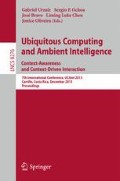Abstract
The process of designing and creating fine Augmented Objects is not an easy task. In this paper we state that Augmented Objects are just interfaces for specific software systems. In this way, the process of design, construction and testing of Augmented Objects should be part of a Software Engineering methodology, likewise Human Computer Interaction deals with software interfaces. A previously proposed methodology for creating Augmented Objects was evaluated. Three new augmented objects were created. Advantages and disadvantages for using this methodology for creating no-traditional interfaces are reported.
Access this chapter
Tax calculation will be finalised at checkout
Purchases are for personal use only
Preview
Unable to display preview. Download preview PDF.
References
Guerrero, L.A., Ochoa, S.F., Horta, H.: Developing Augmented Objects: A Process Perspective. Journal of Universal Computer Science, 1612–1632 (2010)
Sánchez, T., Chinthana, D., Patkai, B., McFarlane, D.: Taxonomy, technology and applications of smart objects. Journal of Information Systems Frontiers, 281–300 (2011)
Alarcón, R., Guerrero, L.A., Ochoa, S.F., Pino, J.: Analysis and Design of Mobile Collaborative Applications using Contextual Elements. Computing and Informatics, 469–496 (2006)
Guerrero, L.A., Ochoa, S.F., Pino, J.A., Collazos, C.: Selecting Devices to Support Mobile Collaboration. Group Decision and Negotiation, 243–271 (2006)
Vega, M., Casado, D., Valero, M.: Smart Spaces and Smart Objects interoperability Architecture (S3OiA). In: Conference on Innovative Mobile and Internet Services in Ubiquitous Computing, pp. 725–730 (2012)
Hervás, R., Bravo, J., Fontecha, J.: Awareness marks: adaptive services through user interactions with augmented objects. In: Personal and Ubiquitous Computing, pp. 409–418 (2011)
Wong, C.Y., McFarlane, D., Zaharudin, A.H., Agarwal, V.: The intelligent product driven supply chain. In: Proceedings of the IEEE International Conference on Systems, Man and Cybernetics (2002)
Ishii, H., Ullmer, B.: Tangible bits: towards seamless interfaces between people, bits and atoms. In: Proceedings of the ACM SIGCHI Conference on Human Factors in Computing Systems, pp. 234–241 (1997)
Author information
Authors and Affiliations
Editor information
Editors and Affiliations
Rights and permissions
Copyright information
© 2013 Springer International Publishing Switzerland
About this paper
Cite this paper
López, G., López, M., Guerrero, L.A. (2013). Improving the Process for Developing Augmented Objects: An HCI Perspective. In: Urzaiz, G., Ochoa, S.F., Bravo, J., Chen, L.L., Oliveira, J. (eds) Ubiquitous Computing and Ambient Intelligence. Context-Awareness and Context-Driven Interaction. Lecture Notes in Computer Science, vol 8276. Springer, Cham. https://doi.org/10.1007/978-3-319-03176-7_15
Download citation
DOI: https://doi.org/10.1007/978-3-319-03176-7_15
Publisher Name: Springer, Cham
Print ISBN: 978-3-319-03175-0
Online ISBN: 978-3-319-03176-7
eBook Packages: Computer ScienceComputer Science (R0)

